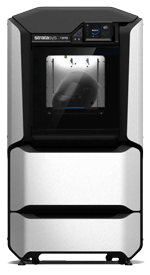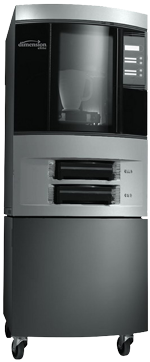3D Printing
3D Printing
The 3D printing process builds a three-dimensional object from a computer-aided design
(CAD) model, usually by successively adding material layer by layer, which is why
it is also called additive manufacturing, and unlike conventional machining, casting
and forging processes, where material is removed from a stock item or poured into
a mold and shaped by means of dies, presses and hammers.
The term "3D printing" covers a variety of processes in which material is joined or
solidified under computer control to create a three-dimensional object, with material
being added together (such as liquid molecules or powder grains being fused together),
typically layer by layer. In the 1990s, 3D-printing techniques were considered suitable
only for the production of functional or aesthetical prototypes and a more appropriate
term was rapid prototyping. As of 2019 the precision, repeatability and material range
have increased to the point that some 3D-printing processes are considered viable
as an industrial-production technology, whereby the term additive manufacturing can
be used synonymously with "3D printing". One of the key advantages of 3D printing
is the ability to produce very complex shapes or geometries, and a prerequisite for
producing any 3D printed part is a digital 3D model or a CAD file.
The most-commonly used 3D-printing process is a material extrusion technique called
fused deposition modeling (FDM).
The DDGT department utilizes 3D Printers for a variety of reasons. Students will be
asked to create drawing plans based off of a 2D drawing of a part or assembly. We
often 3D print parts and assemblies so that students can better visualize the parst
and assemblies they are designing. We also utilize the 3D Printers to teach a process
known as "Reverse Engineering". Reverse Engineering is when you already have a working
part that was made as a functional prototype and then a drawing must be created based
on that part. We have a variety of parts that are already printed and students will
have one assignment a semester to reverse engineer a part or assembly. This is very
common in the industry. Lastly, students create their own designs and 3D print them
which they keep. 3D Printing is incorporated in the A.S. Degree two-year program but
you can also take DDGT130 Introduction to 3D Printing as a separate stand-alone class.
The DDGT department currently has two Stratasys FDM 3D Printers including the F170 and the Dimensions 768 SST. Both printers maintain automatic operation and are operated
with thier own proprietary software. The GrabCAD Print for the F170 and the Catalyst®
EX software for the Dimension 768 SST both automatically import STL files, orient
the parts, slice the files, generates support structures (if necessary), and will
creates a precise deposition path to build your model. Multiple models can be packed
within the build envelope to maximize efficiency. GrabCAD Print and Catalyst® EX
provide queue management capabilities, build time, material status and system status
information. FDM 3D Printers run unattended and provide system and build status information
via e-mail, pager, or the Internet.

F170
Stratasys F123 Professional 3D Printer Series
Product Specifications:
Build Size:
Maximum size 254 x 254 x 254 mm
(10 x 10 x 10 inches)
Materials:
PLA, ABS-M30, ASA, QSR Support Material.
PLA plastic is available in black, white, red, blue, light gray, medium gray, green
translucent, natural translucent, red translucent, and blue translucent.
ABS plastic is available in ivory, black, white, red, blue, green, yellow, orange,
and dark gray.
ASA plastic is available in ivory, black, white, red, blue, green, yellow, orange,
dark gray, and light gray.
Support Structures and Removal:
FDM automatically creates any needed support structures to complete the part. FDM
offers a soluble support removal process for hands-free model completion.
Layer Thickness:
PLA: .245mm (.010 in.)
ABS and ASA: .330mm (.013 in.), .254mm (.010 in.), .178mm (.007 in.), or .127mm, (.005in.)

Dimension 768 SST
Product Specifications:
Build Size:
Maximum size 203 x 203 x 305 mm
(8 x 8 x 12 inches)
Materials:
ABS plastic in standard white, blue, yellow, red, green or steel gray colors.
Support Structures and Removal:
FDM automatically creates any needed support structures to complete the part. FDM
offers a soluble support removal process for hands-free model completion.
Layer Thickness:
.245 mm (.010 in.) or .33 mm. (.013 in.)
